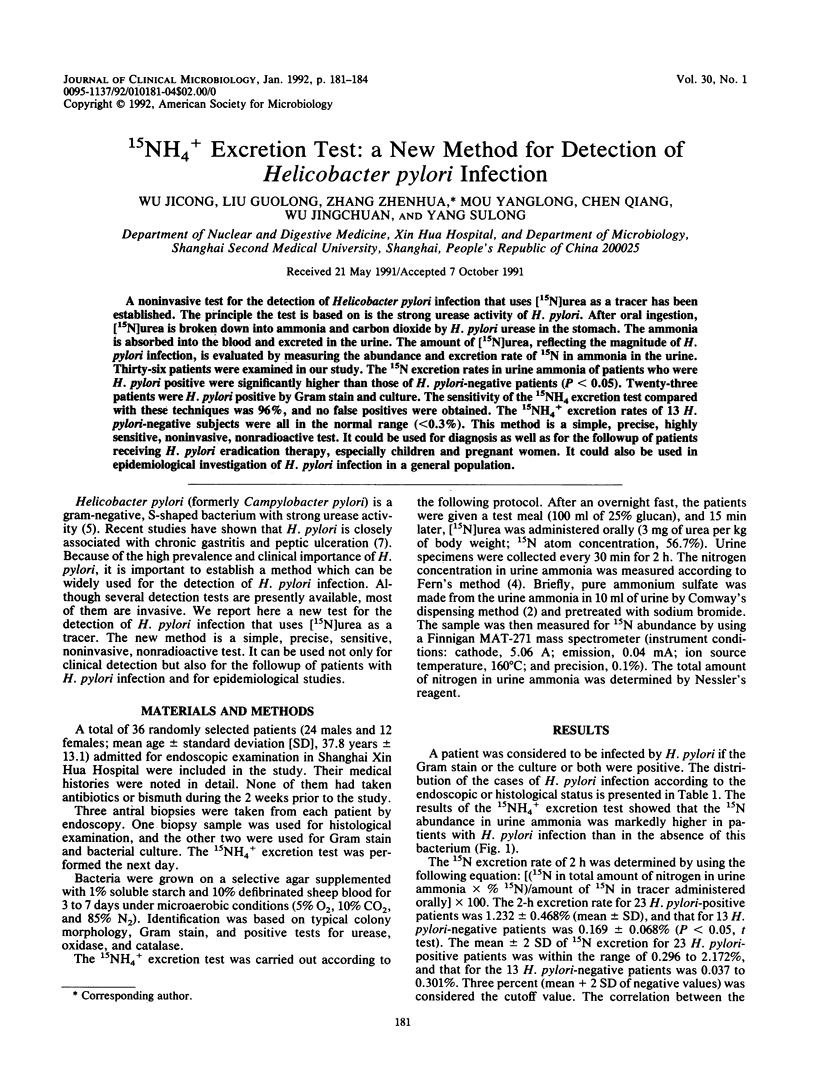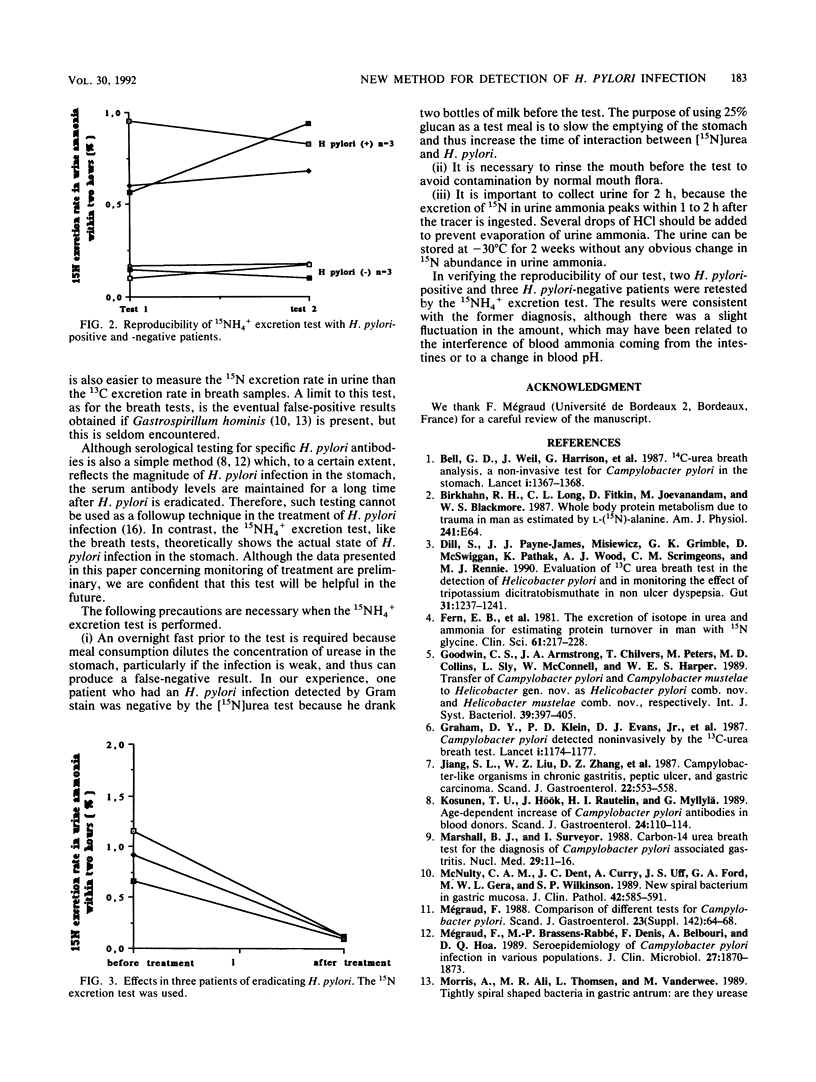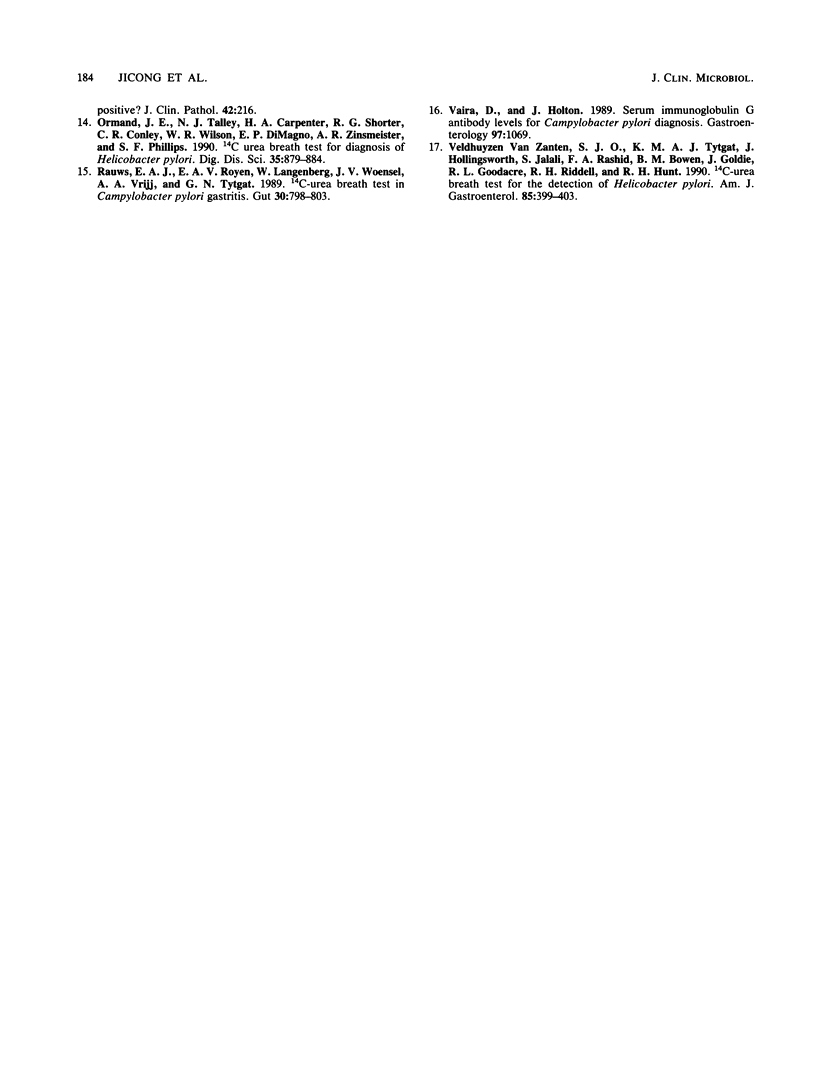Abstract
A noninvasive test for the detection of Helicobacter pylori infection that uses [15N]urea as a tracer has been established. The principle the test is based on is the strong urease activity of H. pylori. After oral ingestion, [15N]urea is broken down into ammonia and carbon dioxide by H. pylori urease in the stomach. The ammonia is absorbed into the blood and excreted in the urine. The amount of [15N]urea, reflecting the magnitude of H. pylori infection, is evaluated by measuring the abundance and excretion rate of 15N in ammonia in the urine. Thirty-six patients were examined in our study. The 15N excretion rates in urine ammonia of patients who were H. pylori positive were significantly higher than those of H. pylori-negative patients (P less than 0.05). Twenty-three patients were H. pylori positive by Gram stain and culture. The sensitivity of the 15NH4 excretion test compared with these techniques was 96%, and no false positives were obtained. The 15NH4+ excretion rates of 13 H. pylori-negative subjects were all in the normal range (less than 0.3%). This method is a simple, precise, highly sensitive, noninvasive, nonradioactive test. It could be used for diagnosis as well as for the followup of patients receiving H. pylori eradication therapy, especially children and pregnant women. It could also be used in epidemiological investigation of H. pylori infection in a general population.
Full text
PDF



Selected References
These references are in PubMed. This may not be the complete list of references from this article.
- Bell G. D., Weil J., Harrison G., Morden A., Jones P. H., Gant P. W., Trowell J. E., Yoong A. K., Daneshmend T. K., Logan R. F. 14C-urea breath analysis, a non-invasive test for Campylobacter pylori in the stomach. Lancet. 1987 Jun 13;1(8546):1367–1368. doi: 10.1016/s0140-6736(87)90664-7. [DOI] [PubMed] [Google Scholar]
- Birkhahn R. H., Long C. L., Fitkin D., Jeevanandam M., Blakemore W. S. Whole-body protein metabolism due to trauma in man as estimated by L-[15N]alanine. Am J Physiol. 1981 Jul;241(1):E64–E71. doi: 10.1152/ajpendo.1981.241.1.E64. [DOI] [PubMed] [Google Scholar]
- Dill S., Payne-James J. J., Misiewicz J. J., Grimble G. K., McSwiggan D., Pathak K., Wood A. J., Scrimgeour C. M., Rennie M. J. Evaluation of 13C-urea breath test in the detection of Helicobacter pylori and in monitoring the effect of tripotassium dicitratobismuthate in non-ulcer dyspepsia. Gut. 1990 Nov;31(11):1237–1241. doi: 10.1136/gut.31.11.1237. [DOI] [PMC free article] [PubMed] [Google Scholar]
- Fern E. B., Garlick P. J., McNurlan M. A., Waterlow J. C. The excretion of isotope in urea and ammonia for estimating protein turnover in man with [15N]glycine. Clin Sci (Lond) 1981 Aug;61(2):217–228. doi: 10.1042/cs0610217. [DOI] [PubMed] [Google Scholar]
- Graham D. Y., Klein P. D., Evans D. J., Jr, Evans D. G., Alpert L. C., Opekun A. R., Boutton T. W. Campylobacter pylori detected noninvasively by the 13C-urea breath test. Lancet. 1987 May 23;1(8543):1174–1177. doi: 10.1016/s0140-6736(87)92145-3. [DOI] [PubMed] [Google Scholar]
- Jiang S. J., Liu W. Z., Zhang D. Z., Shi Y., Xiao S. D., Zhang Z. H., Lu D. Y. Campylobacter-like organisms in chronic gastritis, peptic ulcer, and gastric carcinoma. Scand J Gastroenterol. 1987 Jun;22(5):553–558. doi: 10.3109/00365528708991897. [DOI] [PubMed] [Google Scholar]
- Kosunen T. U., Hök J., Rautelin H. I., Myllylä G. Age-dependent increase of Campylobacter pylori antibodies in blood donors. Scand J Gastroenterol. 1989 Jan;24(1):110–114. doi: 10.3109/00365528909092247. [DOI] [PubMed] [Google Scholar]
- Marshall B. J., Surveyor I. Carbon-14 urea breath test for the diagnosis of Campylobacter pylori associated gastritis. J Nucl Med. 1988 Jan;29(1):11–16. [PubMed] [Google Scholar]
- McNulty C. A., Dent J. C., Curry A., Uff J. S., Ford G. A., Gear M. W., Wilkinson S. P. New spiral bacterium in gastric mucosa. J Clin Pathol. 1989 Jun;42(6):585–591. doi: 10.1136/jcp.42.6.585. [DOI] [PMC free article] [PubMed] [Google Scholar]
- Mégraud F., Brassens-Rabbé M. P., Denis F., Belbouri A., Hoa D. Q. Seroepidemiology of Campylobacter pylori infection in various populations. J Clin Microbiol. 1989 Aug;27(8):1870–1873. doi: 10.1128/jcm.27.8.1870-1873.1989. [DOI] [PMC free article] [PubMed] [Google Scholar]
- Mégraud F. Comparison of different tests for Campylobacter pylori. Scand J Gastroenterol Suppl. 1988;142:64–68. [PubMed] [Google Scholar]
- Ormand J. E., Talley N. J., Carpenter H. A., Shorter R. G., Conley C. R., Wilson W. R., DiMagno E. P., Zinsmeister A. R., Phillips S. F. [14C]urea breath test for diagnosis of Helicobacter pylori. Dig Dis Sci. 1990 Jul;35(7):879–884. doi: 10.1007/BF01536802. [DOI] [PubMed] [Google Scholar]
- Rauws E. A., Royen E. A., Langenberg W., Woensel J. V., Vrij A. A., Tytgat G. N. 14C-urea breath test in C pylori gastritis. Gut. 1989 Jun;30(6):798–803. doi: 10.1136/gut.30.6.798. [DOI] [PMC free article] [PubMed] [Google Scholar]
- Vaira D., Holton J. Serum immunoglobulin G antibody levels for Campylobacter pylori diagnosis. Gastroenterology. 1989 Oct;97(4):1069–1070. doi: 10.1016/0016-5085(89)91543-6. [DOI] [PubMed] [Google Scholar]
- Veldhuyzen van Zanten S. J., Tytgat K. M., Hollingsworth J., Jalali S., Rshid F. A., Bowen B. M., Goldie J., Goodacre R. L., Riddell R. H., Hunt R. H. 14C-urea breath test for the detection of Helicobacter pylori. Am J Gastroenterol. 1990 Apr;85(4):399–403. [PubMed] [Google Scholar]


